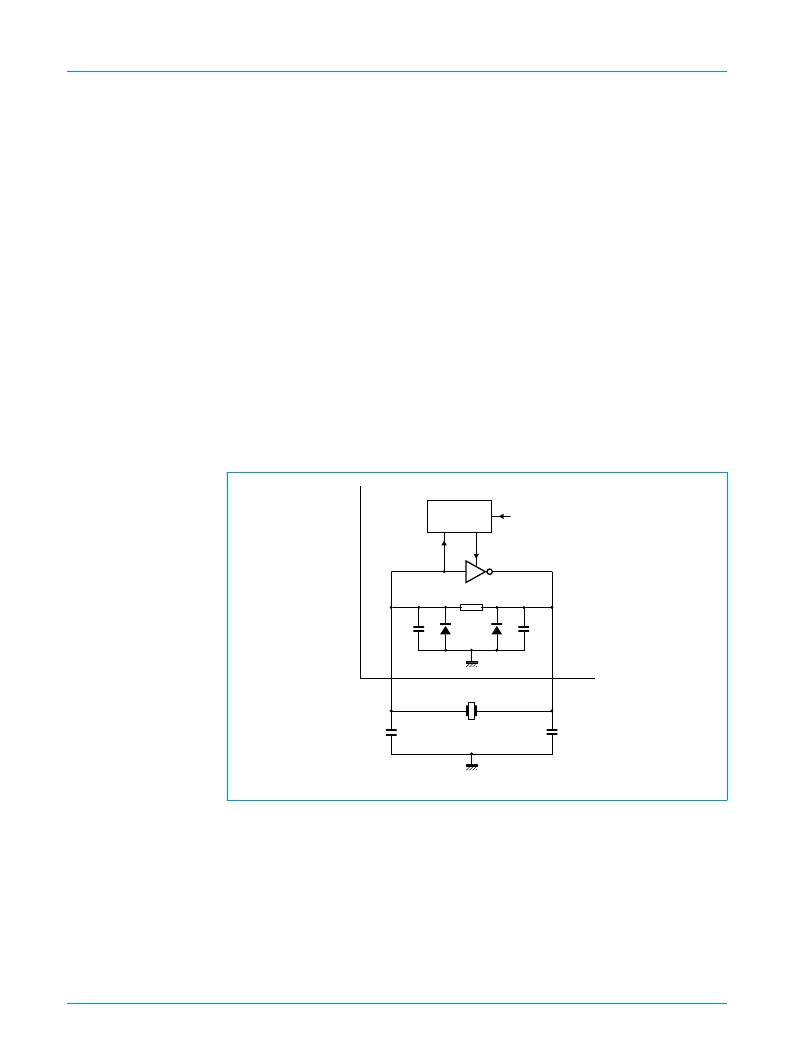- 您現(xiàn)在的位置:買(mǎi)賣(mài)IC網(wǎng) > PDF目錄382379 > PCD3316 (NXP Semiconductors N.V.) Caller-ID on Call Waiting CIDCW receiver PDF資料下載
參數(shù)資料
| 型號(hào): | PCD3316 |
| 廠(chǎng)商: | NXP Semiconductors N.V. |
| 英文描述: | Caller-ID on Call Waiting CIDCW receiver |
| 中文描述: | 來(lái)電呼叫等待CIDCW編號(hào)接收機(jī) |
| 文件頁(yè)數(shù): | 8/30頁(yè) |
| 文件大小: | 534K |
| 代理商: | PCD3316 |
第1頁(yè)第2頁(yè)第3頁(yè)第4頁(yè)第5頁(yè)第6頁(yè)第7頁(yè)當(dāng)前第8頁(yè)第9頁(yè)第10頁(yè)第11頁(yè)第12頁(yè)第13頁(yè)第14頁(yè)第15頁(yè)第16頁(yè)第17頁(yè)第18頁(yè)第19頁(yè)第20頁(yè)第21頁(yè)第22頁(yè)第23頁(yè)第24頁(yè)第25頁(yè)第26頁(yè)第27頁(yè)第28頁(yè)第29頁(yè)第30頁(yè)

Philips Semiconductors
PCD3316
CIDCW receiver
Product specification
11 March 1999
8 of 30
9397 750 04824
Philips Electronics N.V. 1999. All rights reserved.
Unetited
7.9 The internal Power-on reset (POR)
long as V
DD
is below a predefined level V
POR(H)
. If V
DD
exceeds V
POR(H)
, the
3.58 MHz oscillator will start. The PCD3316 is initialized and the internal registers are
set to the default value (see
Section 7.13
). It takes a maximum of 100 cycles of the
3.58 MHz clock to initialize all internal functions. The POR circuitry also ensures, that
the chip will be switched off as soon as a falling V
DD
reaches a predefined level
(V
POR(L)
).
7.10 3.58 MHz oscillator circuitry
The 3.58 MHz oscillator is needed for the FSK receiver and the CAS detection. This
on-chip Amplitude Controlled Oscillator (ACO) circuitry is a single-stage inverting
amplifier biased by an internal feedback resistor R
fb
. The oscillator circuit is shown in
Figure 5
. When using a quartz resonator to drive the oscillator, normally no external
components are needed.
When using ceramic resonators to drive the oscillator, in some cases external
components are needed; refer to the ceramic resonator product specifications. Two
different configurations are shown in
Figure 6a
and
Figure 6b
.
To drive the device with an external clock source, apply the external clock signal to
HXIN, and leave HXOUT to float, as shown in
Figure 6c
. If the amplitude of the input
signal is less than V
DD
to DGND or a sine wave is applied, capacitive decoupling is
needed as shown in
Figure 6d
.
In the Power-down mode (Mode register 2, bit 7 = 0), the oscillator is stopped and
HXIN and HXOUT are internally pulled LOW. The current of the whole oscillator is
switched off.
Fig 5.
Oscillator.
handbook, halfpage
MGK723
C1i
C1e
C2i
C2e
Rfb
AMPLITUDE
CONTROL
on/off
PCD3316
HXOUT
HXIN
1
2
相關(guān)PDF資料 |
PDF描述 |
|---|---|
| PCD3316T | Caller-ID on Call Waiting CIDCW receiver |
| PCD3330-1 | Multistandard repertory dialler/ringer with EEPROM |
| PCD3330-1P | Multistandard repertory dialler/ringer with EEPROM |
| PCD3330-1T | Multistandard repertory dialler/ringer with EEPROM |
| PCD3354AH | 8-bit microcontrollers with DTMF generator and 256 bytes EEPROM |
相關(guān)代理商/技術(shù)參數(shù) |
參數(shù)描述 |
|---|---|
| PCD3316T | 制造商:PHILIPS 制造商全稱(chēng):NXP Semiconductors 功能描述:Caller-ID on Call Waiting CIDCW receiver |
| PCD3316TD-T | 制造商:未知廠(chǎng)家 制造商全稱(chēng):未知廠(chǎng)家 功能描述:Caller Number ID Circuit |
| PCD3320CD | 制造商:未知廠(chǎng)家 制造商全稱(chēng):未知廠(chǎng)家 功能描述:Pulse Telephone Dialer |
| PCD3321CD | 制造商:未知廠(chǎng)家 制造商全稱(chēng):未知廠(chǎng)家 功能描述:Pulse Telephone Dialer |
| PCD3322CP | 制造商:未知廠(chǎng)家 制造商全稱(chēng):未知廠(chǎng)家 功能描述:Pulse Telephone Dialer |
發(fā)布緊急采購(gòu),3分鐘左右您將得到回復(fù)。